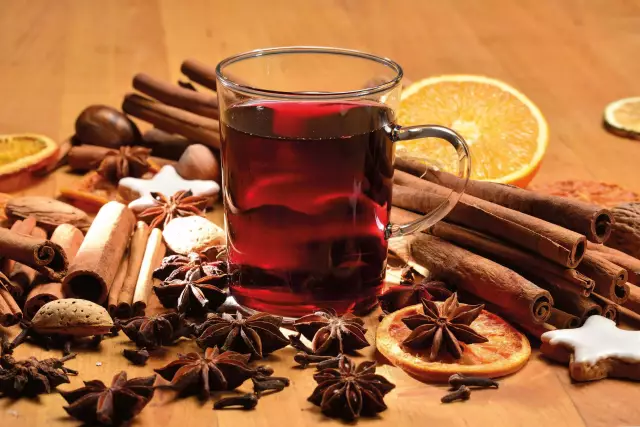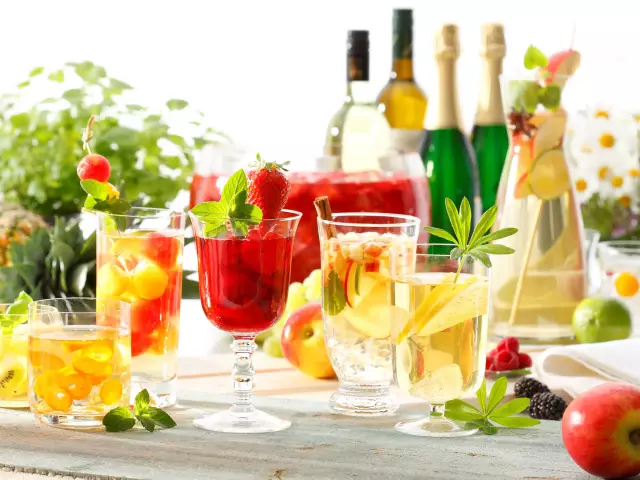Mulled Wine
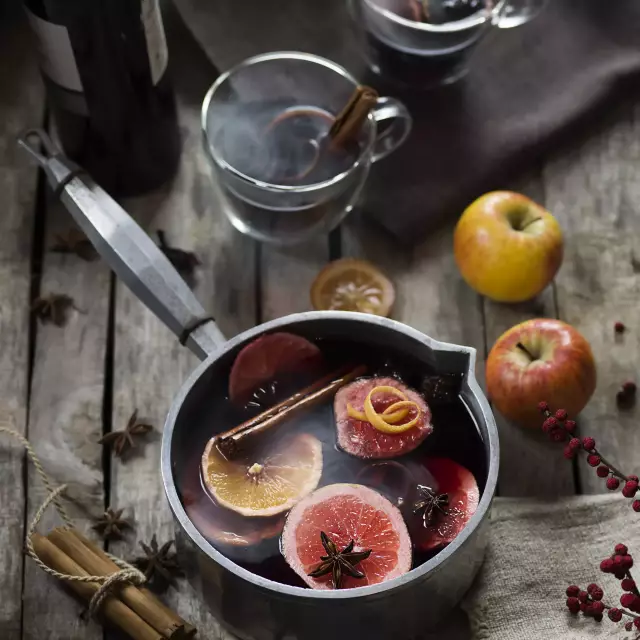
The adding of spices to wine has a very long tradition in the world of wine. The Romans already flavoured some of their wine with sugar and spices to make it more pleasurable and longer lasting.
Facts
-
7 - 14,5
alcohol content by volume
-
from 78°C
heat causes the alcohol to escape
More and more German winegrowers offer home-made mulled wine based on individual recipes partly in organic quality. The very fruity red wines from the German wine-growing regions are well suited for aromatic mulled wine. By warming the wine, the aromas, which are reminiscent of red fruit, become even more expressive and are wonderfully harmonious in combination with the flavouring ingredients. White mulled wines, made from Riesling or Müller-Thurgau for example, are also on offer.
Since 2022, rosé mulled wine may finally be marketed as such by name. A new specification in the EU regulation now allows this. In terms of wine law, mulled wine is a flavoured beverage containing wine, made exclusively from red, rosé or white wine and sweetened and flavoured. The addition of alcohol as well as water or colouring is prohibited. The actual alcohol content must be at least 7% vol. and less than 14.5% vol.
Warming
When warming the mulled wine you should make sure not to heat it too much or even let it simmer, as otherwise delicate fruit aromas will be lost and bitter agents will develop. Additionally, from a temperature of 78°C, alcohol will evaporate.
Flavouring
Don’t add too many spices all at once, and only little amounts. Too many cloves spoil the mulled wine. Cinnamon, star anise and allspice in too large amounts can cover the fruity aromas of the wine as well. Sweeten cautiously. If you are already using a semi-sweet wine, you often don’t need much sugar or honey.
Pay attention to quality
Make sure to use fresh spices and a quality wine. Designations such as "Winzer-Glühwein" (vintner’s mulled wine), or "Weingut" (wine estate) on the label guarantee that the mulled wine was made only from the producers‘ own wines and on their own premises. The designation "Deutscher Glühwein" (German mulled wine) on the label means that only domestic base wines were used.
Have enough time at hand
After the first warming let the mulled wine steep for a few hours, maybe even over night, so that the aromas can fully unfold. Then use a sieve to remove the spices for better enjoyment.
Drink in moderation
You will have the greatest pleasure if you use high-quality ingredients and drink mulled wine in moderation.
Recipe tips
Recipe ideas for dishes to go with mulled wine in the DWI Genießershop: shop.deutscheweine.de
Does mulled wine always have to be red wine?
No! For some years now, white mulled wines have also been in greater demand. As a new trend, fruity rosé mulled wines have also developed as a light counterpart to the heavy red wines.
Varietals

with semi-dry wines Flädlesuppe
with semi-dry wines
- 1 Bund Schnittlauch
- 1 Liter Fleischbrühe
- 150 Gramm Weizenmehl
- 300 ml Milch
- nach Belieben Speckschwarte zum ausreiben der Pflanne
- Etwas Salz
Make a smooth, not too thick batter from the flour, milk, eggs and a pinch of salt. Heat a heavy frying pan on a high heat, rub with bacon fat, pour in a small dollop of batter, allow to spread and fry thin pancakes (flädle).
<p
<p>Leave the pancakes to cool, halve and cut into thin strips.
Place in clear, very hot meat stock and serve immediately.
<p- Trollinger (halbtrocken & feinherb)
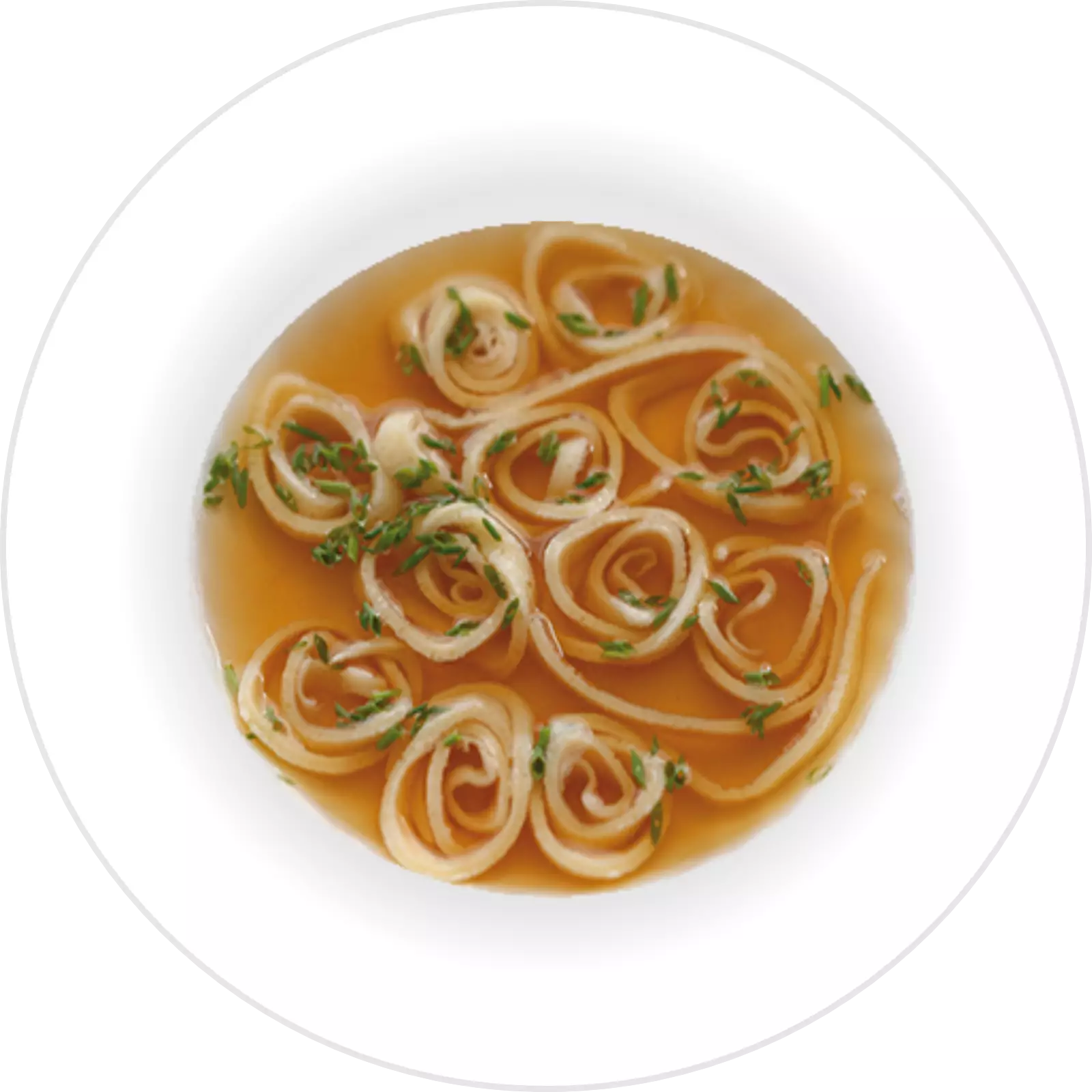
Asparagus again at last Rocket salad with green asparagus and turkey breast fillet
A light, young Rivaner goes well with green asparagus.
- 400g Grüner Spargel
- 100g Rucola
- 400g Putenbrustfilets
- 200g Kirschtomaten
- 4 Eier
- 1 EL Basilikum-Pesto
- 1TL Butter
- 2 EL Olivenöl
- 2 EL Weißwein-Essig
- etwas Salz, Pfeffer
Peel the lower third of the asparagus and cut off the ends. Cut the spears in half and cook in boiling salted water with 1 tsp butter for approx. 7 mins. Set the asparagus water aside.
Cook the eggs until almost firm (the yolk should still be a little soft), peel and cut into quarters. Cut the turkey breast fillet into strips.
Fry the pine nuts briefly without fat in a non-stick pan. Then add a little fat directly to the pan and fry the turkey breast strips. Then keep them warm.
Mix the pesto with the white wine vinegar, 5 tbsp of the asparagus water, the olive oil and salt and pepper in a salad bowl to make a dressing.
Wash the rocket and add to the dressing. Halve the cherry tomatoes and add to the bowl. Mix in the asparagus and turkey. Finally, garnish with the quartered eggs and pine nuts.</p
<p>This goes well with freshly baked ciabatta bread.
Wine recommendation:
A light Rivaner from the last harvest, fresh as spring, with delicate flavours.
- Müller-Thurgau (brut)
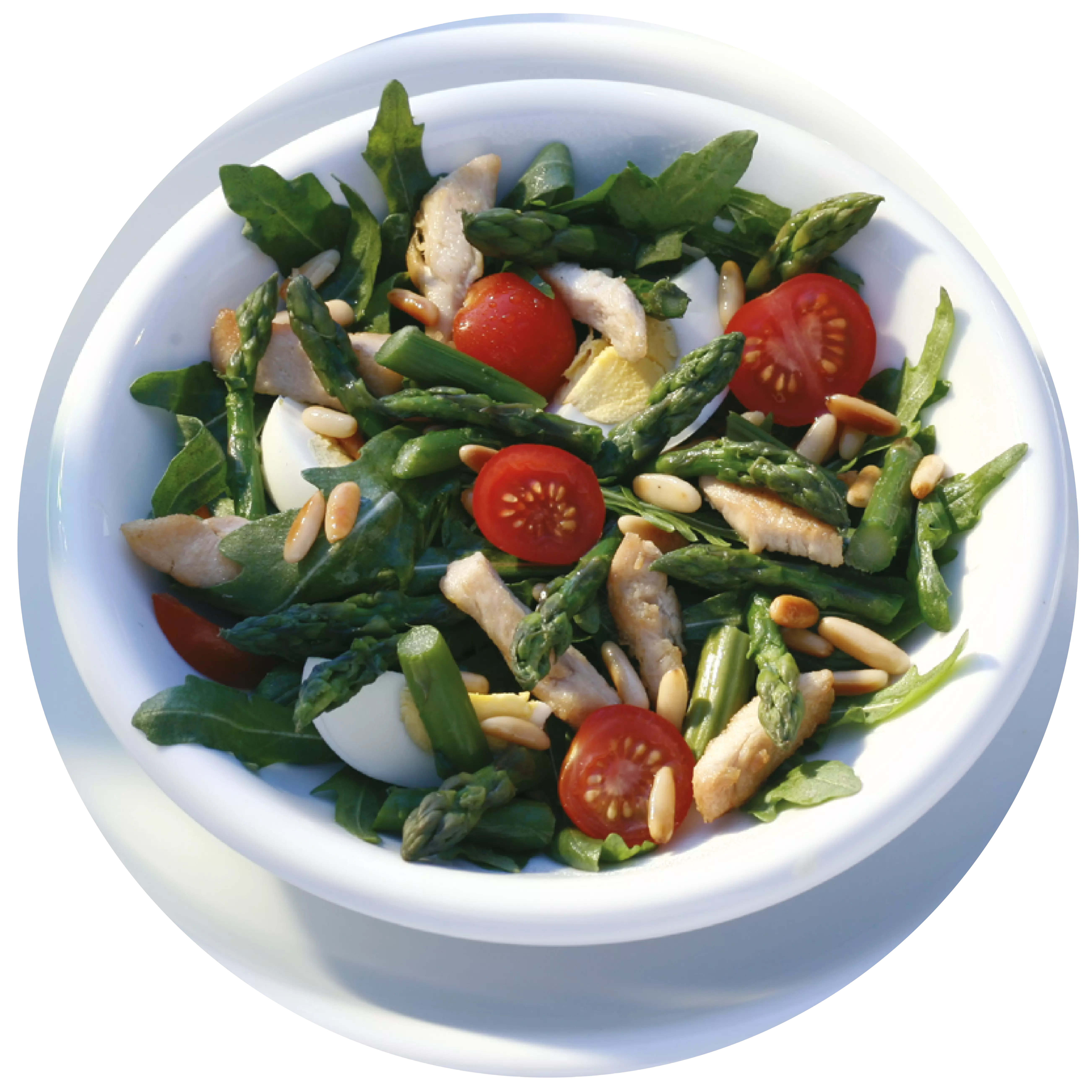
in a bacon coating Lamb
in a bacon coating
- 4 Stück Lammlachse à 150 g
- 4 Scheiben Bacon
- 0,1 Liter Wein
- 0,3 Liter Gemüsebrühe
- 1 kleine Schalotte
- 20 Gramm Butter
- 4 EL Olivenöl
- je 2 Zweige Thymian, Rosmarin, Salbei
- nach Geschmack Salz & Pfeffer
Season the lamb salmon with pepper and massage 2 tbsp of olive oil into the meat. Finely chop the thyme, rosemary and sage and season the meat in the herbs. Marinate in the fridge for a few hours.
<p
<p>Wrap the meat with the bacon slices and sear on all sides in the remaining olive oil. Continue to cook for approx. 4 minutes on each side over a low heat (the cooking time depends on the thickness of the lamb loin - it is best to do a pressure test). Then wrap in aluminium foil and leave to rest in the oven at 80 °C – so they remain juicy and slightly pink on the inside.
This goes well with Bärlauch risotto.
- Dornfelder (trocken)
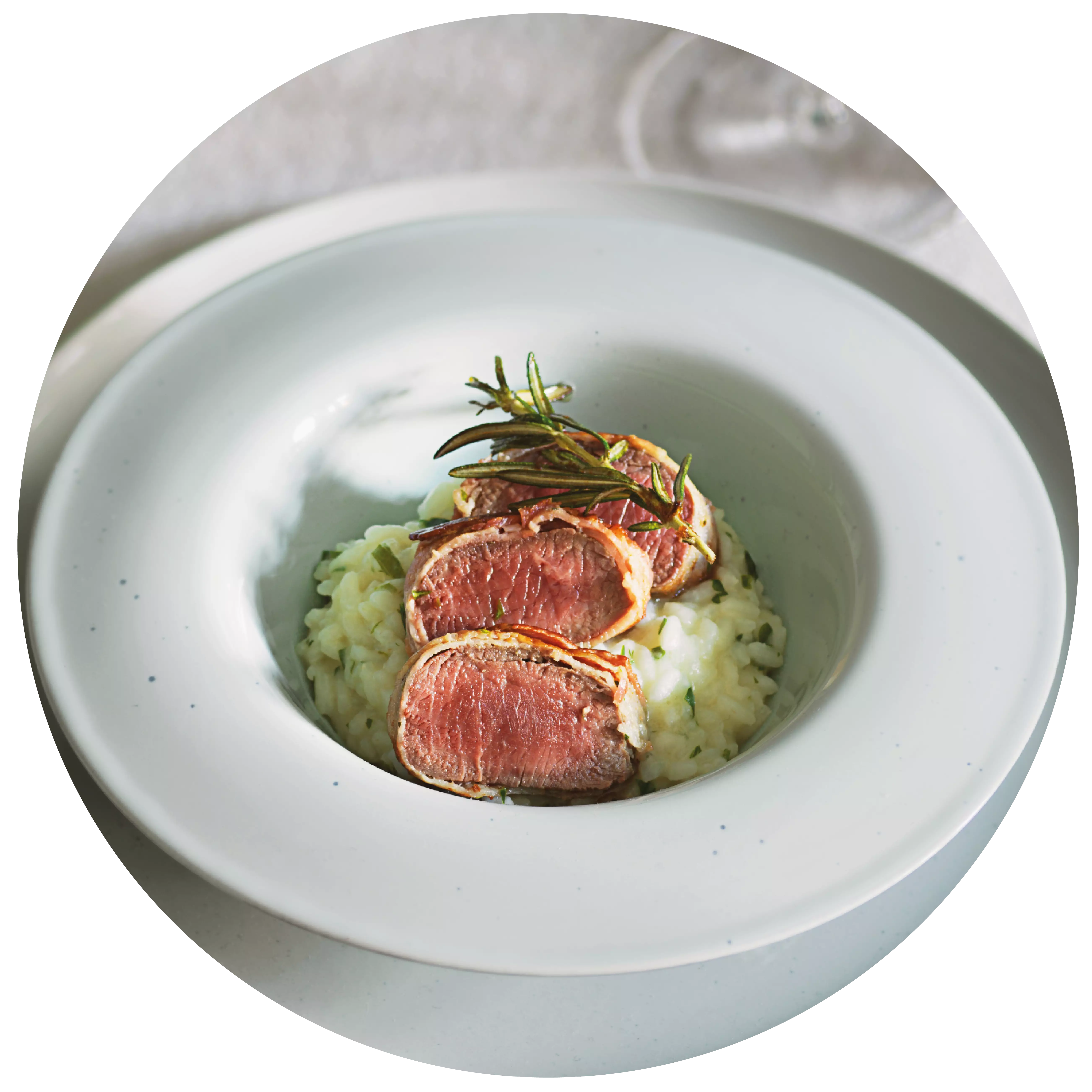
with pears, beans, parsley root and black walnuts Venison medallions
with pears, beans, parsley root and black walnuts
- 12 Stück Rehmedaillions (a 80g)
- 30 Gramm gebratene Speckstreifen
- 200 ml Bechamelsauce
- 3 EL Sonnenblumenöl
- 8 kleine Petersilienwurzeln mit Grün (alternativ Knollensellerie)
- 6 - 8 breite Schnippelbohnen
- 1 große Birne
- 4 - 6 schwarze Walnüsse
- 100 ml Wildfond
- 2 EL Butter
- 2 Stängel glatte Petersilie
- nach Geschmack Salz
Preheat the oven to 180 °C top and bottom heat. Clean, peel and trim the parsley roots. Clean the beans and cut into diagonal pieces. Blanch the parsley roots and beans separately in boiling salted water and rinse immediately in iced water.
Cut the walnuts into eighths and warm in the game stock. Wash the unpeeled pear, cut into eighths, remove the core and cut into thin slices. Fry the venison medallions on both sides in oil, then finish cooking in the oven for approx. 3 - 5 minutes.
In the meantime, toss the beans and parsley roots in melted butter and season with salt. Arrange the vegetables with the black walnuts and pear slices on large plates. Place the medallions on top, garnish with game stock, Béchamel sauce and bacon strips.
Tip: You can make your own black walnuts. To do this, prick the walnuts all over with a fork or skewer and place in water for 10 days. Change the water every day so that the tannic acid can drain off. Boil the nuts 3 times in salted water until they are deep black. Simmer with bay leaves and peppercorns for approx. 20 minutes until soft. Layer in preserving jars and cover with syrup. The nuts can be kept for approx. 1 year.
- Spätburgunder / Pinot Noir (trocken)
- Pinot Gris (trocken)
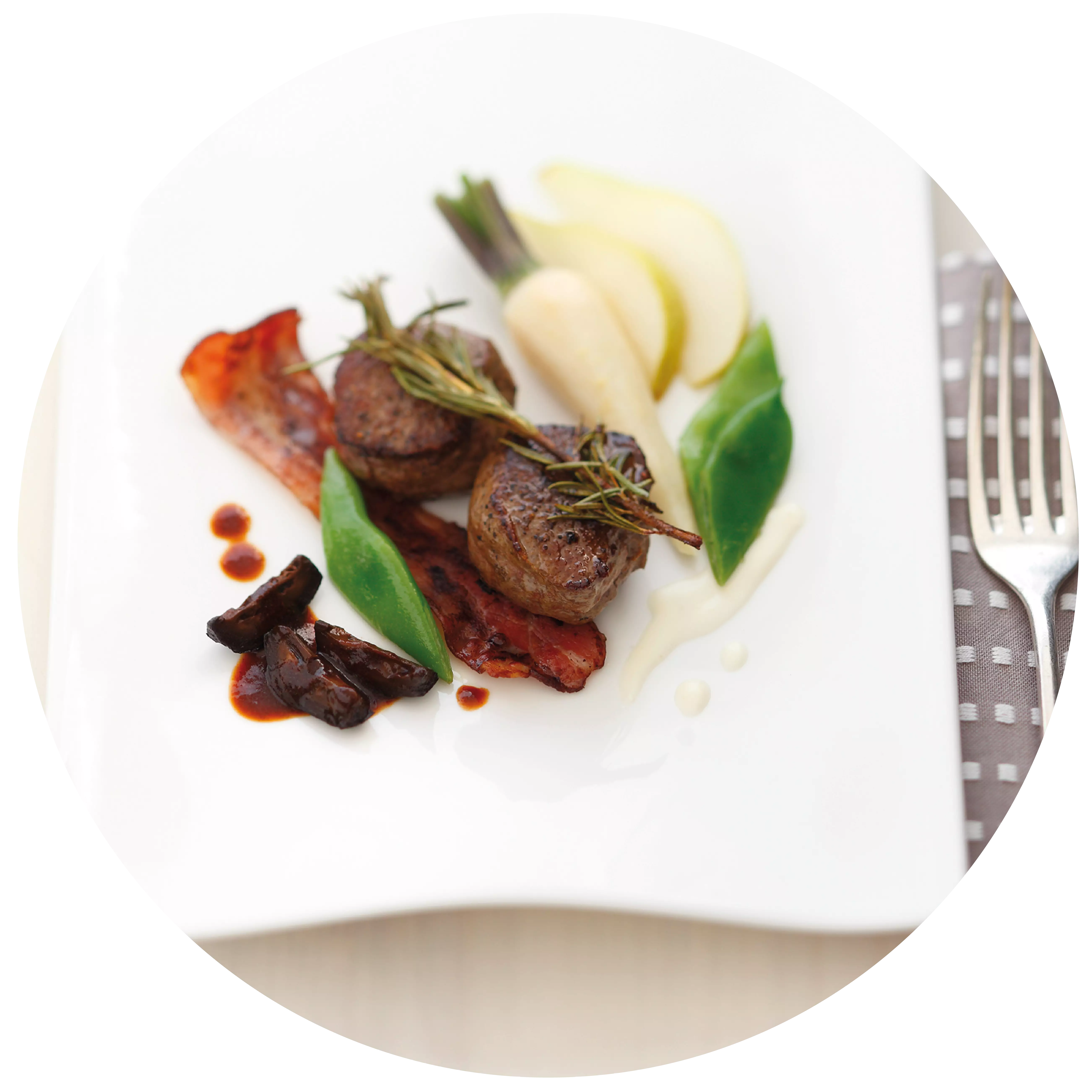
Teaser
Events
-
Show
winetasting in our winery - blind tasting
Mainz-Hechtsheim




